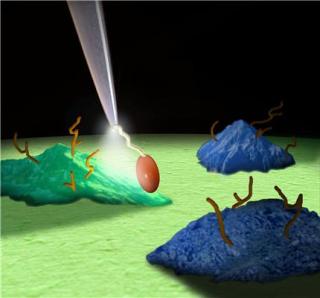Mar 19 2015
The idea is to solve the problem at the cellular level to implement early diagnosis and therapy.

Wanting to achieve early cancer detection, a group of scientists from the Center for Research in Optics (CIO) of Guadalajara, in Mexico, seeks to address the problem from the cell with optical radiation.
"The idea is to find diagnostic and therapeutic solutions to health problems like cancer at a cellular level," specifies Gabriel Ramos Ortiz, PhD in Optical Sciences.
The challenge is to generate nanostructures capable of identifying the presence of cancerous cells in an organism or biological tissue by obtaining an image thereof. The nanostructures have to be selective and indicate only the damaged area, says the scientist.
It is therefore necessary to develop organic nanoparticles with optical properties (luminescence and photon absorption), which when exposed to infrared radiation emit intense light that can help find specific areas where the problem is located.
The researcher states that different from chemotherapy or surgery, which are aggressive and affect other organs, infrared optical radiation can be used to create an image of diagnosis or provide therapy at the cellular level targeting only the damaged areas.
"A lot of the diagnosis is made by biopsy. The ideal for us is to detect the problem in the office or at a simple clinical level, through a technique that signals the issue when it is just starting. In addition, biophotonics offers noninvasive solutions, because it can be applied selectively in the area where cancer is located, while chemotherapy generates collateral damage throughout the body, "says Gabriel Ramos.
Also, scientists at CIO are studying the optical radiation for implementation in microscopy in order to obtain specific images of the cancer cell.
Optical radiation, unlike traditional microscopy, works according to excite the sample by laser. "By stimulating a biological specimen with infrared laser radiation, fluorescent light is obtained which can then be collected and get a clear picture. With the above, we can recognize the biological structure of the cell, its dynamics and physiology, "adds the expert.
Authentication and quality control of beverages
Moreover, the Center for Research in Optics is developing a technique based on photonics to serve in quality and authenticity control of alcoholic beverages such as tequila. The technique consists of making optical radiation (light) interact with tequila, and analyze obtained information in order to know if it is a hundred percent authentic and if an adequate quality control was followed .
Gabriel Ramos explains that tequila reposado is aged in barrels that give the beverage a characteristic color "that is easy to fake with dye or candy; however, the barrel contains an unique 'fingerprint', which is revealed by focusing light on the tequila, which provides different information depending on whether it is authentic or if the color comes from a molecule of caramel "and thus the purity of the product is determined.
This system can reduce time and cost in quality control, because the authorities are slow to apply analytical tests to determine authenticity.